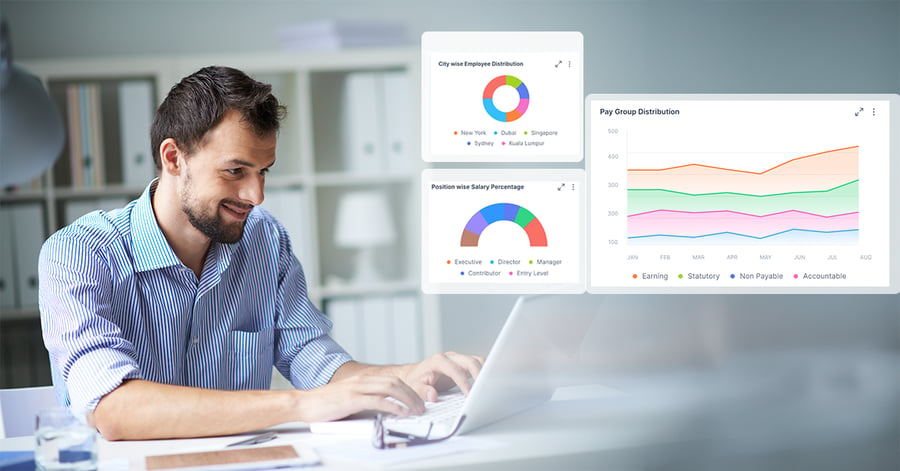
- Home
- Global Payroll
- Payroll Analytics: From Local Execution to Global Intelligence
Payroll Analytics: From Local Execution to Global Intelligence
Payroll Analytics: From Local Execution to Global Intelligence
11:49
Published :

Payroll is, by definition, local. It’s shaped by tax codes, social insurance systems, labor laws, and cultural expectations that vary from country to country. But the way we work today isn’t local at all. Our talent strategies are global, our teams are distributed, and our compliance obligations cross borders. That puts payroll professionals in a tricky spot. We must ensure precise execution in each jurisdiction while also providing insights at the global level. And that’s exactly why we need to rethink the payroll profession through payroll analytics.
Over the past few years, I’ve worked with many organizations that still treat payroll as a collection of siloed local tasks. Each country handles its own compliance, processes its own pay runs, and files its own reports. It’s a structure that minimizes local risk, but it also blinds the business to opportunities. Because buried inside those systems is something very powerful: data that, when connected and analyzed using payroll analytics, reveals patterns in employee behavior, performance, cost, and risk.
The companies I see making real strides in workforce planning and cost optimization are the ones that have figured this out and are acting on it. With payroll professionals in the lead!
Every time we run payroll, we capture signals about the behavior of our workforce - valuable inputs that can be harnessed through payroll analytics for global intelligence:
The problem is that most of these insights are captured in local systems. Without data standardization at the global level and the use of payroll analytics, finance struggles to get real-time visibility into global labor costs. HR can’t evaluate the impact of retention strategies when turnover data isn’t aggregated. And operations can’t compare productivity or cost drivers across regions. I’ve seen global leaders try to make high-stakes decisions based on fragmented spreadsheets, inconsistent KPIs, and data that was weeks old. That is not just inefficient. It’s risky.
A lack of integration also creates strategic blind spots. Leaders can’t answer basic questions about how the business is performing globally. They can’t compare labor costs across markets in a meaningful way or understand how cultural or regulatory differences are influencing outcomes. And when businesses operate on assumptions instead of of payroll analytics and global intelligence, they tend to make reactive, suboptimal choices.
We don’t need a single payroll engine that runs every country. That’s rarely realistic or necessary. What we need is a global analytics layer powered by payroll analytics that sits on top of local systems, ingests their data, standardizes it, and makes it visible and meaningful to the right people. This approach doesn’t sacrifice local compliance or disrupt existing operations. It simply brings clarity and consistency to the data we already have, enabling global intelligence.
The impact of this change is immediate and noticeable. Finance can monitor labor costs in real time, by department or region, without waiting for consolidated reports. HR can track retention trends, spot outliers, and identify best practices that can be scaled globally. Operations can align staffing with business needs more precisely, because they’re working from complete, current data. I’ve seen organizations cut decision-making time in half simply because they’re no longer guessing (or waiting for someone to merge reports in Excel!).
The good news is that the technical barriers to this kind of integration are rapidly disappearing. APIs, cloud platforms, and data visualization tools make it possible to connect systems and surface insights faster than ever. The challenge we face is organizational. Leaders must treat payroll data as a strategic asset, not just an operational detail. That shift in mindset, driven by forward-looking payroll professionals, is where the real transformation begins, unlocking the full potential of payroll analytics and global intelligence.
For decades, payroll reporting has been backward-looking. We’ve told the business what happened last month: who got paid, how much it cost, and whether it was compliant. That kind of reporting still matters. But it’s no longer enough.
Real-time payroll analytics is changing the game. When we can see what’s happening in the workforce right now (not just what happened last quarter) we can respond instead of react. For example, if overtime suddenly spikes in one region, we can explore whether it’s a temporary workload issue or a sign of chronic understaffing. If attrition is rising faster than expected, we can look into which roles or teams are affected and take action before it becomes a full-blown problem.
I’ve seen companies use real-time dashboards powered by payroll analytics to detect unusual bonus activity, severance spikes, or absenteeism patterns that would otherwise have gone unnoticed until it was too late to intervene. And as market conditions shift more rapidly, that speed becomes essential. Annual planning cycles just don’t cut it anymore. Businesses need to adapt workforce plans in near real time. And payroll data is the most reliable source they have.
Of course, having data isn’t the same as acting on it. Real-time payroll intelligence only works when organizations build the decision-making frameworks to use it. That means giving the right people access to the right insights at the right time, as well as having processes in place to escalate issues and coordinate responses across regions.
Once we have consolidated data and unlocked real-time visibility, the next step is prediction. This is where things get really exciting for payroll professionals!
With the right models in place, we can forecast future outcomes with surprising accuracy using payroll analytics to drive global intelligence. We can:
I’ve worked with organizations that use predictive payroll analytics to guide everything from headcount planning to retention strategy. One client was able to identify flight risk indicators among high-performing employees months before any formal resignation happened, and they used that insight to adjust compensation and development plans in time to retain them. Another was able to reallocate staff between regions based on projected productivity and cost metrics, leading to meaningful improvements in output and employee satisfaction.
Predictive payroll analytics and global intelligence are particularly valuable when your organization is planning a change. Whether it’s entering a new market, adapting to remote work models, or preparing for mergers and acquisitions, having a data-driven forecast of workforce costs and risks provides a critical edge in scenario planning.
Payroll is often the largest expense. But many organizations don’t truly understand the full cost of employment across different markets, roles, and regions. And without that understanding, optimization efforts tend to be blunt instruments: used for cost-cutting rather than value-building.
With global payroll analytics, you can look beyond base salaries. You can account for benefits, tax obligations, social contributions, compliance overhead, and even relative productivity. This gives us a much clearer picture of where labor spend is most effective and where improvements are possible.
The same applies to vendor management cost. When you can compare error rates, service levels, and processing costs across providers and countries, you’re in a much stronger position to negotiate or streamline your payroll delivery model, leveraging payroll analytics to drive cost optimization.
One area where payroll analytics delivers almost immediate ROI is compliance. You already know that managing payroll compliance across multiple jurisdictions is complex, time-consuming, and risky. Regulations vary widely, and manual oversight often isn’t enough.
But with payroll analytics and global intelligence, you can monitor for compliance breaches in real time, such as unapproved overtime, late filings, or misaligned pay equity ratios. You can also stay ahead of regulatory change by modeling what upcoming legislation might mean for our payroll processes, costs, and obligations.
This kind of proactive compliance doesn’t just reduce legal and financial risk. It also builds trust with regulators, auditors, and employees. At a time when pay transparency and ethical governance are increasingly under scrutiny, being able to demonstrate rigorous, data-driven oversight is a serious advantage.
All of this points to a bigger shift: the evolution of payroll professionals from processors to strategic advisors. As payroll becomes the people OS (see the first blog in this series), and analytics becomes central to payroll, we need to build new skills and take on new responsibilities.
This includes developing fluency in strategy, data, learning how to interpret trends, and understanding how payroll insights connect to broader business outcomes. It also means collaborating more closely with HR, finance, IT, and compliance teams, and sometimes even starting and leading those conversations.
I genuinely believe we’re at an inflection point. Payroll professionals who embrace this shift will find new opportunities to shape strategy, influence leadership, and accelerate their careers. Those who don’t may see their roles become more automated and less valued.
The future of payroll is about much more than accurate pay runs. It’s about leveraging local operational excellence to create global strategic intelligence. It’s about turning a validated workforce dataset into something that drives informed business decisions, improves performance, and manages risk. That requires investment: not just in technology, but in people, processes, and perspective.
The data is already there. The tools are available. The business needs are growing louder by the day. Now it’s time for payroll professionals to step forward, claim your place at the strategy table, and show the world what you are capable of. This transformation will elevate our entire profession from administrative support to strategic partnership, creating unprecedented opportunities for career advancement and organizational influence.
Because global payroll isn’t just a function. It’s an intelligence engine. And it’s our job to make sure it runs at full power!
Enterprise asset management (EAM) involves the management of mission critical assets of an organization throughout each asset's lifecycle. EAM is used to plan, optimize, execute, and track the needed maintenance activities with the associated priorities, skills, materials, tools, and information. The aim is to optimize the quality and utilization of assets throughout their lifecycle, increase productive uptime and reduce operational costs.
Enterprise asset management (EAM) involves the management of the maintenance of physical assets of an organization throughout each asset's lifecycle. EAM is used to plan, optimize, execute, and track the needed maintenance activities with the associated priorities, skills, materials, tools, and information.
The software helps in effective maintenance of assets through preventive, predictive, shutdown and breakdown maintenance strategies. The system also helps enterprises mitigate equipment risks by enhanced safety standards. The streamlined operations and improved asset performance helps organizations increase their investment effectiveness.
EAM is important because it helps organizations track, assess, manage and optimize asset quality and reliability. Asset intensive Organizations have hundreds, thousands, even millions of assets which needs to be maintained to maximize / optimize life of these assets to increase the return on investment.
The key features of effective EAM are:
Asset Intensive companies under the following Industries :
Contact us for a meeting and schedule a demo
This differs on case to case basis, based on the type of installation and unique industry specific requirements. Contact us for a meeting and schedule a demo.
This differs on case to case basis, based on the type of installation and unique industry specific requirements. Contact us for a meeting and schedule a demo.
Stay Connected, follow us on LinkedIn / Twitter to know more about EAM Software latest trends.

Anita Lettink is a Future of Work expert with deep expertise in HR Technology and Payroll transformation. Recognized as a LinkedIn Top Voice, a Top 25 Future of Work Thought Leader, and a Top 100 HR Tech Influencer, she helps organizations worldwide adopt innovative HR and payroll solutions. Anita is the author of What’s Up With My Pay?, Equal Pay for Equal Work, and How to Select Your Next Payroll. Based in the Netherlands, she enjoys running as her favorite way to discover new places.

All Rights Reserved. © Copyright 2024. Ramco Systems.